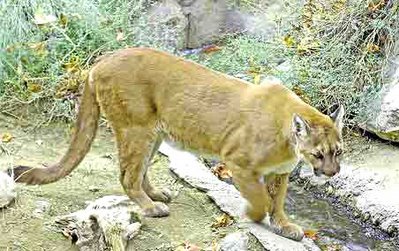Elusive Wild Beauty

by Steven Harper
The shear wild beauty of the sculpted body that lay before me left me awestruck. I knelt on the ground, reached out, and touched this decent size mountain lion. Half of my attention in reverent fascination with this stunning creature, the other half of my attention scanning the environment for any signs my five senses might pick up. This beautiful cat was not resting or sleeping—it was dead— and something had killed it. It did not take long to determine that this lion had not been shot as I originally suspected, but it had died just a few hours before our discovery. All the signs were there, another mountain lion, presumably more agile, larger, and experienced, had taken this cat. While I have observed rare animals in many parts of the planet, wild mountain lions had often eluded me. Now, I finally had a chance to touch, to smell, to examine up-close this elusive animal.
Mountain lions (Puma concolor, also commonly known as cougar) were originally found over most of North America all the way down to the tip of South America. Although much is still not known about these reclusive animals, its current range in the United States is severely reduced to the wild areas of western states. These large cats can inhabit everything from deserts to high mountains, however, for the most part they prefer forested and dense brushy areas with occasional clearings and few humans. This, of course, describes many parts of Monterey County. Since 1972 there has been a ban on trophy hunting mountain lions in California. In some areas their populations have continued to decline despite the ban. Cougars are solitary and depending on the habitat can need an average of 100 square miles of territory or more. As human population increases cougar habitat has become more fragmented and has decreased in size, causing more contact with humans. Often it is inexperienced juveniles that have been pushed to the edges of wild areas that people encounter.
Nothing in the animal kingdom moves with quite the mix of grace, stealth, and agility of cats. Mountain lions are perhaps the pinnacle of this feline poetry in motion. With exceptional wide-angle night vision, the ability to hear well beyond human range, running speeds of 50 mph, and the bounding and leaping abilities that far exceed Olympians, cougars are the elite athletes of the wilds. Adults are generally 5-8 feet long including the tail. The tan color of their fur blends well with California’s vegetation. Their tail is long with a dark tip that measures 1/3 their body length. Adults can weigh anywhere for 90 to 180 pounds. The cougar I found was a male juvenile and weighed 120 pounds.
Cougars preferred food is almost always deer, although they will take opossum, raccoons, coyotes, and other medium sized mammals. They are nocturnal hunters usually out anytime from dusk to dawn. Adult cougars are secretive and solitary animals that come together only to mate. Young cubs have faint rings around their tails and spots on their body that they lose as they mature. Around 18 months the young are out on their own and must not only find food, but more important, must find territory that is not already taken by other cougars. Less than half will make it past 2 years old.
Mountain lions are the most stealthy and elusive of the large predators of North America. The manner in which most of us will experience these creatures in the wild will be by the signs of their passing by and not by direct contact. The first time I clearly identified mountain lion tracks was on an infrequently used road in Big Sur. There had been a recent rain and the mud on the road made near perfect casts of their large paws. When walking their rear paws often cover the prints of their fore paws. The overall print is round in shape with no claw marks with the forepaw being slightly larger and wider than the hind. Cougars have a unique “M” shape at the front of the pad that further differentiates their track from members of the dog family. Their scat is larger than dogs often containing deer hair and bones. Occasionally I have seen an area where they scuff the groundcover and spray, or have found a scratch post where you can see the claw marks of the cat marking its territory.
In general, predators, and specifically mountain lions, are useful indicator species that tell about the overall health of an ecosystem. Mountain lions are critical to the balance and health of many of California’s natural areas. As we humans go forward, the health of the mountain lion could be an excellent indicator and direct feedback as to our ability to live in balance with the natural world. If nothing else, the shear wild beauty of these magnificent and elusive animals is more than enough reason to protect their place in the family of living things.
Copyright Steven Harper all rights reserved
Labels: cougars, mountain lions, puma, Puma concolor
